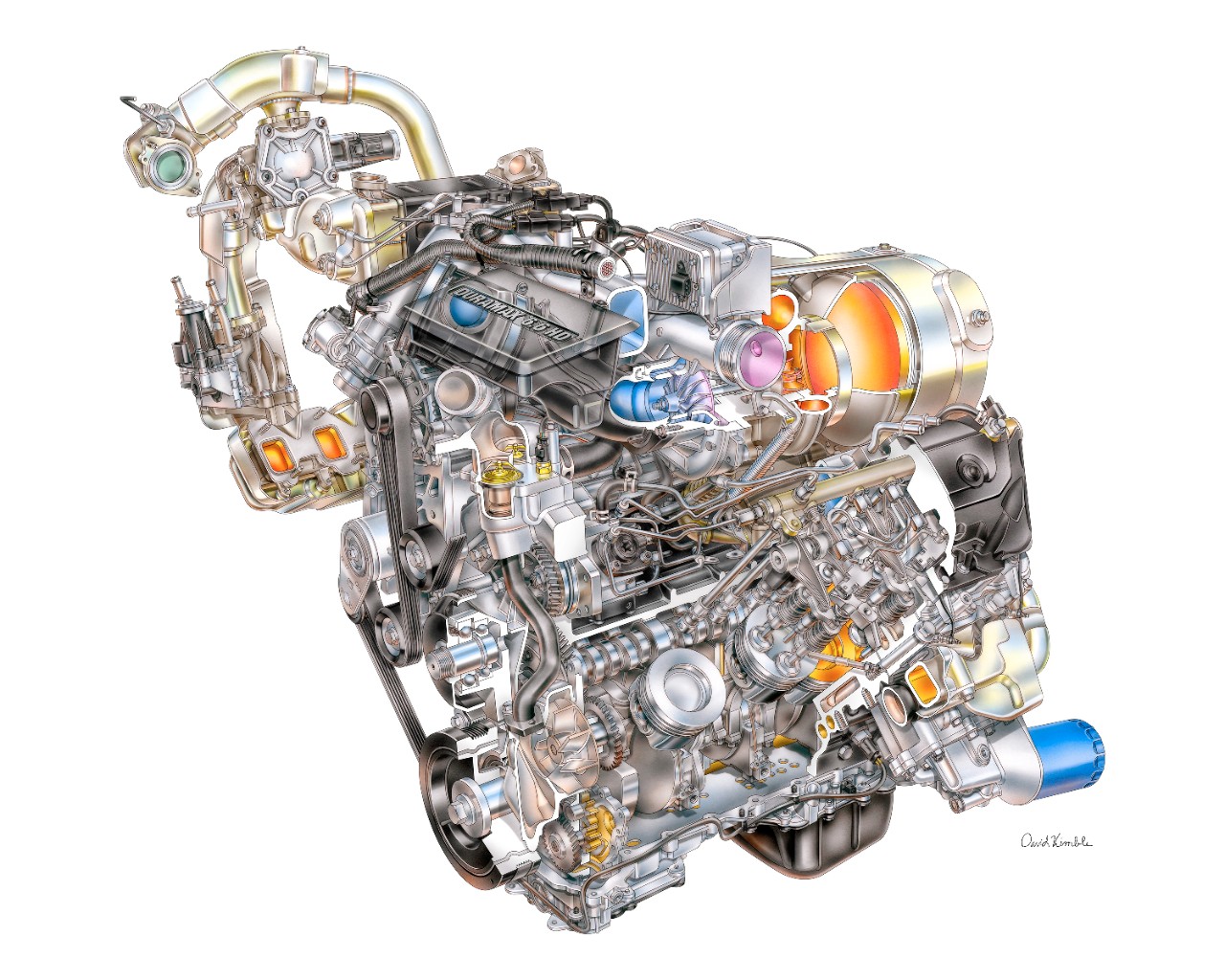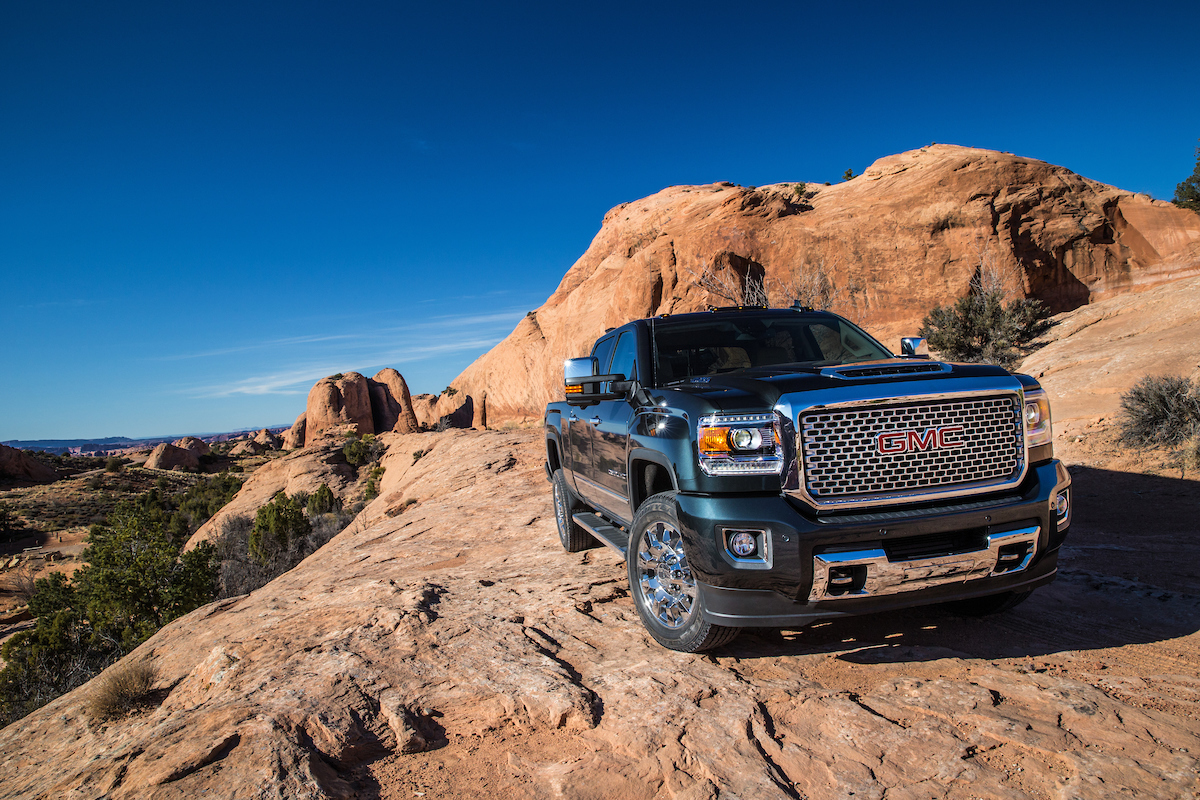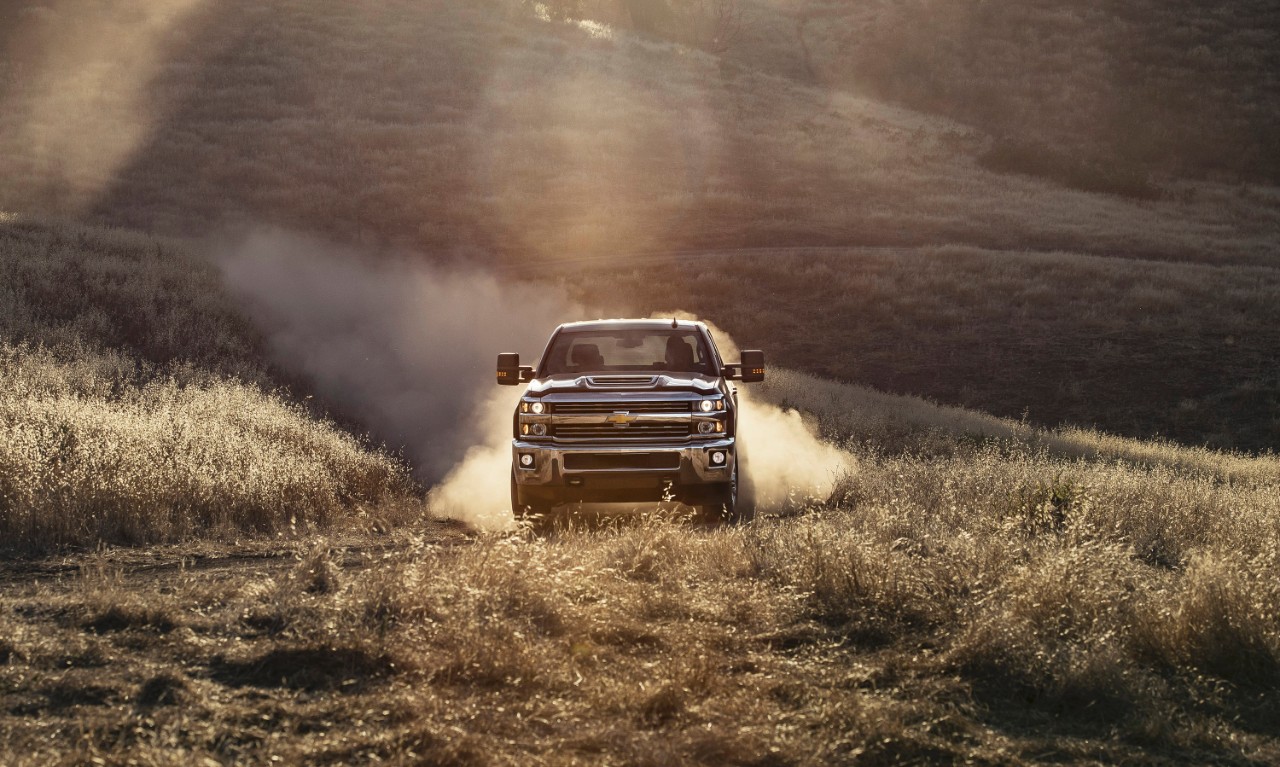‘Chevrolet Forum’ Review: 2017 GMC Sierra 2500 Denali
Quieter and More Powerful, New Sierra’s Many Improvements Give It an Impressive Competitive Edge and Added Driving and Towing Versatility
On the outskirts of a small town along the Utah/Colorado border, I prepare to pass slower traffic in a 2017 GMC Sierra 2500 Denali with the new 6.6L Duramax turbo-diesel V8. My aim is simply to see how the new Duramax will respond even with a 12-foot long, 9,000-pound trailer in tow. Passing with this much weight and length is often a tense maneuver, with any amount of turbo lag making it worse. Turn signal on, I pull to the left and put the accelerator to the floor. The tachometer and speedometer climb quickly and without delay as I fly through 30, 40, 50 and 60 mph. Thankfully, there is no turbo lag and no sweat either (and no police officer). The new Duramax’s improvements really help, and passing performance is just one of the many improvements.
What’s New on the 6.6L Duramax Turbo-Diesel V8

While some manufactures call engines “new” after making small tweaks, the new Duramax isn’t the case. It has 90 percent new parts over the prior generation. Everything from connecting rods to the nuts and bolts has been redesigned and/or changed in this fifth-generation engine.
GM’s Eric Stanczak, a vehicle chief engineer of full-size trucks and SUVs, says the auto maker focused on many different areas for improvement on the new engine. These areas include torque, horsepower, emissions and engine noise.
Starting with the big items–horsepower and torque–Stanczak says they worked on everything and changed much of it, including a new Borg Warner turbocharger. The changes resulted in a 19 percent gain in torque and 12 percent more horsepower while reducing emissions by 35 percent.
Officially, the new L5P engine (GM’s identification system) produces 445 HP and 910 lb-ft of torque. This is a big jump up from the outgoing LML engine that mustered 397 HP and 765 lb-ft of torque.
The 2017 Sierra’s improved exhaust braking is immediately noticed and really helps while driving on windy canyon roads.
These numbers led GM to wonder just how much better the engine performs. They took a variety of cab configuration trucks and tested them versus the prior generation Duramax. They found:
- 0-60 mph acceleration test – 7.1 seconds (7/10s faster with unladen, 2500HD, Crew Cab, 4×4)
- 50-70 mph acceleration test with a trailer – 10.6 seconds (1.5 seconds faster with 10,000 pound trailer, 2500 HD, Reg Cab, 4×4)
- Up Davis Dam towing at max capacity – 40 seconds faster (23,000 pound trailer, 3500 HD, dual-rear wheel Crew Cab, 4×2)
The various improvements in power are thanks to the various engine parts they switched. New parts include: cylinder heads, pistons, piston pins, crankshaft and connecting rods. All major components upgraded from 150-bar to 180-bar cylinder-pressure capability. This increase in cylinder pressure means it can run hotter for longer, like in the case of pulling a load up Davis Dam. The prior generation might have to throttle back as it neared the summit, but the newer engine can power right through, according to Stanczak.
Also, helping with the power-delivery improvements is the new functional hood scoop, which routes more air into the engine for cooling, high temperature manifolds, pipes and gaskets, as well as a new fuel system timed better to the combustion cycle.
Finally, they improved the exhaust braking with the additional engine torque to help ensure smoother downhill speed control as well as stopping. During my time behind the wheel, the improved exhaust braking is immediately noticed and really helps in a few situations driving on windy canyon roads.
A Quiet Ride

Another area of improvement is the engine noise. Diesel engines have always been notoriously loud and GM wanted to make their diesel quieter. Stanczak says they reduced the loud noise from 86.7 dBA to 84.8 dBA. These numbers translate into a big difference with the newer Duramax diesel being substantially quieter outside and inside the cabin. Thanks to the engine-noise drop, triple-sealed doors and other sound-deadening improvements, it is actually difficult to tell the truck is idling.
During my day of driving it, I have to focus on listening for the diesel sound on many occasions. With the trailer journey, and another trip towing two snowmobiles, as well as listening to several different cab configuration trucks with various loads, the noise improvements are very evident.
Thanks to the engine-noise drop, triple-sealed doors and other sound-deadening improvements, it is actually difficult to tell the truck is idling.
In order to accomplish this goal, Stanczak says they made two key improvements. First, GM added noise cancellation on the rocker (valve) covers. Second, they redesigned the oil pan–the first time we have ever heard of a manufacturer doing such a thing to reduce engine noise.
“I think there are a lot of people who are going to forget it is a diesel as they are cruising along,” says Stanczak.
Transmission Upgrades

Diesels fans are familiar with the legendary powertrain combination of the Duramax and Allison and their reliability. With Duramax diesel horsepower and torque improvements, an upgraded 6-speed transmission was added.
The key improvements for the new Allison A1000 are in the output yoke and torque converter, which help to provide additional power and reduce emissions.
It also plays a key role in the improved exhaust braking as well as cruise-grade braking. This latter item refers to setting the cruise control and allowing the exhaust brake to handle decreases in speed, saving brakes from being overheated. In our drive, we used it on occasion and it worked perfectly, keeping us from riding the brakes.
The Great Torque Race and Rear Axle Ratios

One of the interesting items discussed during my time with engineers was the 910 lb-ft. of torque. Astute diesel fans know this is less than the new Ford Super Duty’s 925 lb-ft. of torque. It is also more than Ram Heavy Duty’s 900 lb-ft. of torque. This brings up a curious question: Why didn’t GM engineers aim to take the lead spot on torque with a figure besting the Super Duty?
Stanczak says it really comes down to meeting the needs of the consumers. GM estimated 86 out of 100 HDs sold are rated for less than 25,000 pounds of towing, and only one out of 100 are rated above 27,500 pounds.
“We believe that meeting the needs of the majority of the market sells more vehicles than a numbers-claim truck,” says Stanczak. “We specifically are not out there looking at the [part of the market towing] 29k-30k pounds… We are looking at the majority of the market in terms of sales.”
Plus, it is difficult to really feel the difference between 15 lb-ft. of torque these days, Stanczak later adds.
Another item of interest related to towing and power is in the rear-axle differential ratio. Many truck owners know that the bigger the rear axle, the more towing prowess you can have. For example, there are “highway” gears, commonly thought of as 3.08 or 3.23, and towing gears like 4.10. In the half-ton market, GM offers a variety of gear sets. However, when configured with the 6.6L Duramax turbo-diesel, the only axle ratio offered is a 3.73. Gasoline Vortec engines are offered in a 3.73 and 4.10.
When asked about why they don’t offer more, Stanczak says they tested out various axle ratios and found the 3.73 to be the sweet spot. Going to a 3.42 didn’t translate into that much better fuel economy. Also, it sacrificed some towing while the 4.10 was too strong for hitting the majority of consumers’ needs. The 3.73 provides enough towing and performance. It also helps with fuel economy over a 4.10. However, GM, like all OEMs, doesn’t publish heavy-duty fuel economy numbers.
The new Duramax diesel is available on Chevrolet Silverado HDs and should be on sales lots now.

